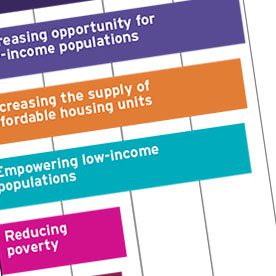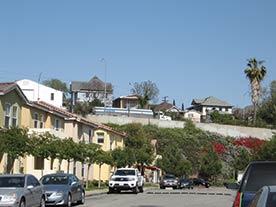In this issue our authors explore many aspects of the community development field, and especially the role of community development corporations in it. But we know you have opinions too. To set the stage, last year we invited our readers to take a survey about how they understood the community development field and community development corporations. The survey was promoted through our weekly newsletter and social media. We got about a hundred responses.
What’s a CDC?
Of our respondents, 63 percent identified as being from a CDC, 24 percent did not, and 13 percent “maybe” did. But what do they understand a CDC to be?
The top three things that define a CDC, according to our survey respondents, are a goal of revitalizing a low-income neighborhood (78 percent), a goal of increasing opportunity for residents of that neighborhood (78 percent), and resident/low-income engagement (74 percent). The other four options we gave — use of housing development to achieve its goals, use of real estate development to achieve its goals, resident/low-income participation in governance, and place-based in a small geography — were all selected by 55 to 59 percent of respondents as well, so clearly many things go into people’s idea of what a CDC is.
Interestingly, respondents who did not identify as representing a CDC were much more likely (over 80 percent) than those who definitely identify as CDCs (42 percent) to define a CDC has being place-based in a small geography. Also non-CDCs were much less likely (59 percent) to define a CDC as a group that had a goal of increasing opportunity for residents of a low-income community than those who did identify as CDCs (86 percent, the clear top answer for that group).
Identifying as a CDC may have something to do with being multi-issue or multi-strategy; those who identified as CDCs selected an average of 6 different activities that their organization conducts from a list of 10 (see chart) as opposed to an average of 3 activities for non-CDCs. While CDCs were more likely to do any given item on the list than non-CDCs were, the difference was greatest for “community organizing for policy change” (46 percentage points more likely), “community facilities development and management” (41 percentage points more likely), and “community planning” (39 percentage points more likely).
What’s Our Goal?
Although community development has often been critiqued of late for having failed to reduce poverty, only slightly more than a third of respondents considered reducing poverty to be even one out of many goals of field. About the same amount selected reducing concentrations of poverty as a goal. In contrast, over three-quarters of respondents selected empowering low-income populations (75 percent), increasing opportunity for low-income populations (79 percent), and increasing the supply of affordable housing (77 percent) as goals of the field, and a full 89 percent selected “revitalizing low-income communities.”
Interestingly, answers to this question did not vary much by whether an organization identified as a CDC or not, though CDCs included both affordable housing development and reducing poverty on their lists at higher rates than non-CDCs.
Those who did select reducing poverty were vastly more likely to also select those other four goals (over 85 percent for each) than vice versa (only 38 percent of those who selected revitalizing low-income communities also selected reducing poverty, for example). However, the four top goals seem to be considered complementary — most people who chose one chose the other three as well.
Thoughts on the CDC Model
How do practitioners and supporters understand how these goals and organizations and activities come together to make community development happen? In a separate survey from last spring we asked whether the “community development model” could be defined, and if so, how. Here are some of the answers:
“True community development is based on community engagement before all else, creating a pathway for leaders to develop from within the community, and then bringing together a critical mass — again from within the community — to identify community needs, determine priorities, and design and implement solutions.”
***
“It is a model based on developing housing and supportive services that give all members of society access to decent and safe neighborhoods with resources to promote upward
mobility.”
***
“Localism, helping the poor or near-poor, trying to get them services, an overall urban emphasis, some but less ruralism, no particular suburban focus (though that may eventually change if times get really hard), a long-term goal of social justice, which may or may not be explicit, a continual and sometimes wearing emphasis on the next funding or funders, [and] an overall lack of an intellectual framework, though that may not be a disadvantage for practical work.” —Frank Popper, Rutgers and Princeton universities, New Brunswick and Princeton, New Jersey
The question seemed to touch a nerve with some, generating several emotional responses about how the term has come to be used to describe activities that are not sufficiently community driven:
“The grass-roots ‘bottom up’ approach often described in the community organizing literature 40 or 50 years ago has been lost – in favor of well-funded government or privately driven efforts to tell low- and working-class people what’s good for them.”
-Donna Hardina, Department of Social Work Education, California State University, Fresno, California
***
“Too much of what is pawned off as community development today is just private developers and outside organizations building subsidized housing in low- and moderate-income neighborhoods. There is no community input.”
***
“Non resident-led CDCs defeat their purpose and stimulate resident resentment.”
We hope the articles on the following pages will help bring some additional insight and useful ideas to this conversation.





As a community practice social worker and organizational development specialist with Habitat for Humanity International, I can say, first hand, that much of what Donna Hardina stated is true; however…
Organizations like the one for which I work – Habitat for Humanity Internaitonal – have seen the light and are investing heavily in Neighborhood Revitalization in which residents initiate, lead and sustain social, economic, physical, and spiritual development in their neighborhoods,
Habitat for Humanity International is serving as a spoke (an affordable housing spoke) in the neighborhood wheel rather than “the“solution to neighborhod wellbeing.
Here is a link to the website: https://www.habitat.org/env/NRI_default.aspx
Dave Cooper, MSW, MDiv, CPM